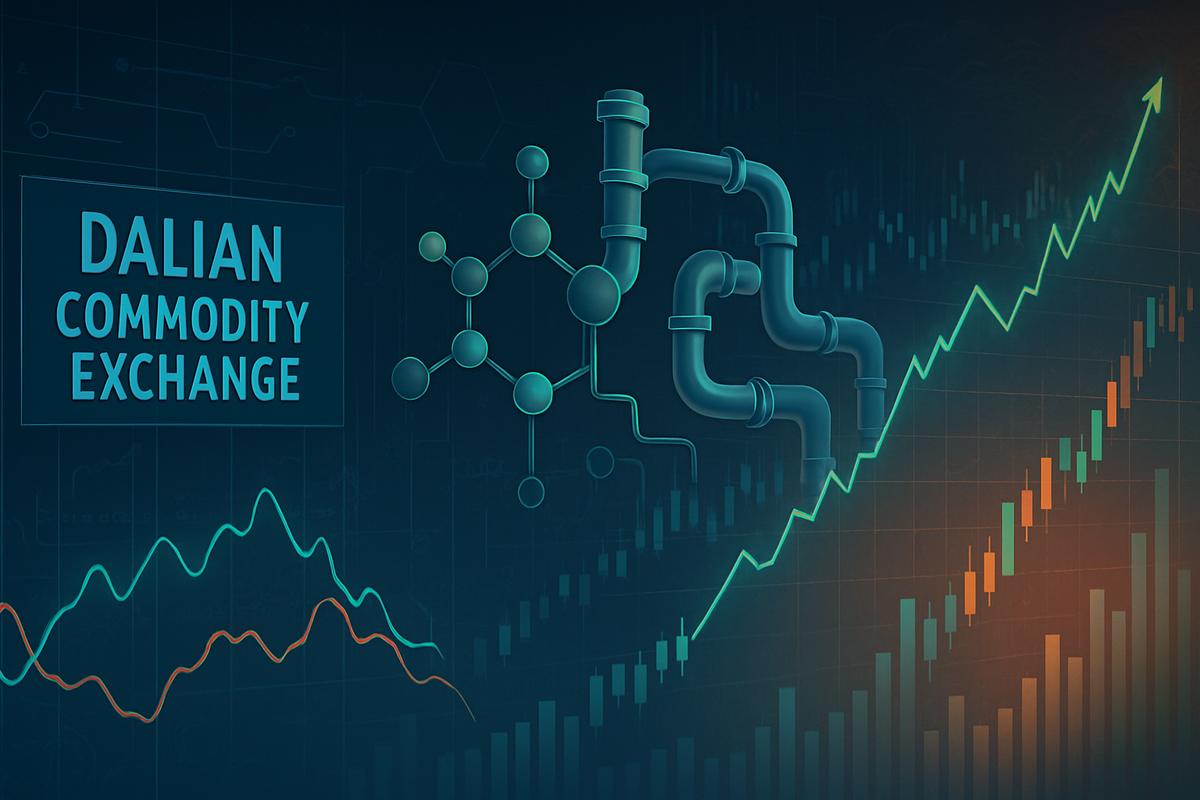
As September 2025 draws to a close, the Dalian Commodity Exchange (DCE) petrochemical futures market presents a complex and varied landscape. Key commodities such as polypropylene (PP), linear low-density polyethylene (LLDPE), and PVC have seen fluctuating fortunes, largely influenced by persistent oversupply, cautious domestic demand, and China's overarching strategic push for high-value industrial growth. This dynamic environment suggests that while some segments grapple with immediate price pressures, the long-term trajectory is being shaped by ambitious national industrial policies.
The immediate implications for the market include a palpable sense of caution, particularly as companies engaged in pre-National Day holiday destocking, often resorting to discounts to clear surplus inventory. This short-term bearish impulse, coupled with broader global economic turbulence and geopolitical trade tensions, sets a challenging tone for the coming months, even as China's long-term vision aims to re-position its petrochemical sector.
Detailed Coverage: A Snapshot of DCE Petrochemical Performance
The closing days of September 2025 revealed a nuanced picture across the Dalian Commodity Exchange's petrochemical offerings. For Polypropylene (PP), the DCE Polypropylene January 2026 futures contract was quoted around 6,899 CNY/MT as of September 29, 2025. This indicates a potential continuation of earlier downward movements observed in the lead-up to the month's end. Similarly, Linear Low-Density Polyethylene (LLDPE), represented by the DLLc1 contract, was listed at 8,072.00 CNY on September 29, 2025, though this figure relies on delayed data from July. Earlier in July, the September 2025 LLDPE contract had shown a modest increase.
PVC futures exhibited a somewhat more resilient performance. The DCE PVC January 2026 contract closed at 4,935 CNY on September 25, 2025, marking a gain of 29 CNY, while the DPVc1 contract was quoted at 4,809.00 CNY on September 29, 2025, also based on delayed data. It's important to note that Ethylene Glycol (EG) futures for September 2025 (VKU25) expired on September 25, 2025, meaning no active closing price for September 30 was available. Furthermore, Purified Terephthalic Acid (PTA), a significant petrochemical, is traded on the Zhengzhou Commodity Exchange (ZCE), not the DCE. On the ZCE, the PTA January 2026 contract closed at 4,678 CNY on September 25, 2025, reflecting a significant increase of 76 CNY.
The overarching trend in late September was a bearish sentiment in the broader ethylene market, largely driven by increased reliability of external ethylene facilities and abundant domestic availability in China. This led to reduced urgency among buyers and subsequent price drops. Key players in this scenario include the Dalian Commodity Exchange (DCE) and Zhengzhou Commodity Exchange (ZCE), which provide the trading platforms, along with numerous Chinese petrochemical producers and downstream manufacturing industries. The Ministry of Industry and Information Technology also plays a crucial role through its strategic planning for the sector. Initial market reactions included widespread pre-holiday discounting to reduce inventory and a generally cautious outlook for October, balancing potential post-holiday demand recovery against anticipated production restrictions and macroeconomic headwinds.
Companies Navigating the Petrochemical Tides
The current market dynamics on the DCE present both challenges and opportunities for public companies operating within the petrochemical value chain. Companies with significant exposure to Polypropylene (PP) and LLDPE production, especially those facing higher inventory levels or less efficient production capacities, might experience pressure on their profit margins. This is particularly true for smaller, less integrated producers heavily reliant on domestic sales and vulnerable to the prevailing oversupply. Downstream manufacturers of plastic products, such as those in packaging or automotive components, could benefit from lower input costs for PP or LLDPE, but this advantage might be offset by sluggish end-user demand.
Conversely, large, integrated petrochemical giants like China Petroleum & Chemical Corporation (Sinopec, HKG: 0386) and PetroChina Company Limited (PetroChina, HKG: 0857), with their diversified product portfolios and robust supply chain management, are generally better positioned to weather price volatility. Their ability to optimize production across various segments and potentially leverage export markets (if global demand improves) could provide a competitive edge. Companies aligned with China's strategic initiatives to expand high-end supply and accelerate breakthroughs in critical products, such as specialized polyolefins, stand to gain in the long run. These firms might benefit from government support, R&D investments, and a growing domestic market for advanced materials, potentially creating new revenue streams despite overall market headwinds.
Furthermore, the impact of falling ethylene prices, as observed in late September, creates a two-sided coin. While producers of ethylene and its primary derivatives face revenue pressure, companies that are net buyers of ethylene for further processing into products like EG or PVC could see their raw material costs decrease. However, this benefit is contingent on their ability to maintain healthy demand for their end products, which remains a challenge in the current environment of muted demand recovery.
Wider Significance: Reshaping China's Petrochemical Future
The mixed performance on the DCE is not merely a short-term blip but reflects deeper, structural shifts within the global petrochemical industry, with China at its epicenter. The prevailing oversupply and cost pressures are global trends, creating a buyer's market where demand recovery has been sluggish due to inventory destocking and broader economic slowdowns. Against this backdrop, China's strategic initiatives, notably the Ministry of Industry and Information Technology's plan for an average annual increase of over 5% in the added value of its petrochemical and chemical industries for 2025-2026, are highly significant. This plan emphasizes expanding high-end supply and accelerating breakthroughs in critical products, aiming to move China up the value chain and reduce reliance on imported advanced materials.
This strategic direction has considerable ripple effects. China's intent to increase domestic production of high-end polyolefins and other specialized chemicals could intensify competition for international producers and potentially reshape global supply chains, cementing China's role as a price-setter. Furthermore, the DCE's expansion of foreign investor access to petrochemical derivatives like PP, PVC, and styrene in 2025 underscores China's ambition to internationalize its commodity markets and offer hedging tools against raw material cost volatility. However, the industry also faces significant regulatory and policy implications, including China's stringent "dual carbon" goals and environmental regulations, which necessitate substantial investments in green technologies and sustainable practices. Globally, the EU's Carbon Border Adjustment Mechanism (CBAM) and potential U.S. tariffs on petrochemical imports add layers of complexity and risk to international trade. Historically, periods of oversupply in the chemical industry have often led to consolidation and technological innovation, and the current environment suggests a similar trajectory, driven by both market forces and strategic national imperatives.
What Comes Next: Navigating Opportunities and Challenges
Looking ahead, the petrochemical market on the Dalian Commodity Exchange is poised for continued evolution. In the short term, the period immediately following China's National Day holiday will be crucial. While there might be a rebound in demand as businesses resume full operations, this could be tempered by the persistent inventory overhang and the cautious sentiment observed in late September. Volatility is likely to remain a key feature, with prices reacting swiftly to macroeconomic data, energy price fluctuations, and any new geopolitical developments impacting trade. Producers will need to carefully manage their inventory levels and production rates to avoid further exacerbating the oversupply situation.
In the long term, China's determined shift towards high-end, specialized petrochemicals will drive significant structural changes. This could lead to increased domestic competition within the advanced materials segment, prompting consolidation among less competitive players. Market opportunities will emerge for companies that can innovate in specialized materials, develop sustainable production methods, and effectively navigate complex regulatory landscapes. Challenges will primarily stem from ongoing trade protectionism, the imperative for environmental compliance, and the need for continuous technological upgrades. Potential scenarios include a gradual stabilization of prices if demand for high-value products grows in line with policy targets, or continued price pressure if global and domestic demand remains subdued while new production capacity comes online.
Comprehensive Wrap-up: A Market in Transition
In summary, the Dalian Commodity Exchange petrochemical market closed September 2025 in a state of transition, characterized by a mixed performance across key commodities. The pervasive theme of oversupply, coupled with cautious demand and pre-holiday destocking, exerted downward pressure on some prices. However, this immediate reality is juxtaposed against China's strategic and ambitious long-term vision to elevate its petrochemical industry towards high-end, specialized products and greater global influence.
Moving forward, the market will be shaped by a delicate balance between these short-term cyclical pressures and the powerful, enduring force of China's industrial policy. Investors should anticipate continued evolution, with an increasing focus on efficiency, innovation, and sustainability. The lasting impact of this period will likely be China's strengthened position as a significant producer and, increasingly, a price-setter in the global petrochemical landscape, particularly for advanced materials. What investors should watch for in the coming months are global demand indicators, the concrete implementation and impact of China's industrial policies, fluctuations in energy prices, and any further developments in geopolitical trade relations that could introduce new variables into this complex equation.
This content is intended for informational purposes only and is not financial advice.





